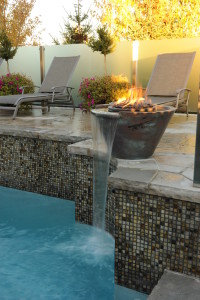
By Barry Justus
All swimming pool, spa and water feature designers/builders have had the experience of walking into an empty backyard and trying to visualize the end result. The yard may be as flat as a pancake, on the edge of a cliff, bottom of a hill, have a great view or have an apartment building for a backdrop. No matter the site conditions, the builder’s task is to design and construct a project that is on budget, meets the client’s needs, is suitable for the site situation, and ideally is creative, functional, safe and unique. To do this successfully, swimming pool designers and builders need to consider the following:
- What is the location of all items in the subject property? A current survey verified with actual site measurements is required;
- What are the legal requirements? (e.g. setbacks, codes, easements, soil conditions, greenbelts, right of ways, etc.);
- What are the actual grades from a survey? Verify actual and survey grades, as visual cues can severely distort grade perceptions;
- Where is the sun? Time of year, shade patterns, overhead trees and neighbouring structures and buildings should all be considered;
- Does privacy need to be created? (e.g. obstruct neighbouring view, block the wind, noise barriers, etc.);
- What are the site’s drainage patterns? This includes swales, protection of existing grades and drainage and safe guarding the project from water drainage patterns; and
- When working on the site of a brand new home, all of the above is required in addition to the plan views, site elevations and renderings of the future home’s architecture
Changing the school of thought
Designers and builders of aquatic structures have the ability to use and manipulate grade and elevations to their advantage. The advent and popularity of 3-D landscaping software makes it relatively easy to showcase multi-level designs to help clients fully understand and visualize the project before the builder breaks ground.
Vanishing edge pools
The traditional school of thought with regards to vanishing edge pools is they can only be located in an area with water in the background (e.g. adjacent to a pond, lake, river or ocean). When installed at the correct grade and viewed from a suitable vantage point, these pools often blend seamlessly into the background. Quite often, the line of site where a vanishing edge pool actually ‘vanishes’ into the aquatic backdrop is quite limited. If the pool is viewed from an upper patio or second-storey bedroom, the pool water does not appear to vanish.
The colour of the pool water versus the shade of the natural body of water in the background often presents another dilemma. The pool water will not change in colour, while the lake in the backdrop could become quite muddy after a storm, thus altering the intended visual effect.
A less traditional design philosophy is to locate a vanishing edge pool in areas without a water backdrop. Site grade manipulation can have a dramatic effect on the visual appeal of the vanishing edge site line, thus allowing these pools to be installed in virtually any backyard. For example:
- Elevate the pool and have the edge close to the viewer side of the pool vanish (i.e. reverse vanishing edge);
- Have the pool water vanish to a green background (e.g. plantings, forest, etc.);
- Have the pool vanish to a city view or mountain vista; or
- Have the pool vanish to an elevated wall located behind the pool or in the adjacent surge tank.
Perimeter overflow pools

For perimeter overflow swimming pools, the traditional view is to locate them in a flat grade setting. These pools works particularly well with a vanishing edge on one or more sides when combined with grade changes on a hill side. Another option is building elevated walls inside the perimeter overflow pool to create an interesting visual element or provide screening and privacy for the client. Negative elevations, swim-up bars, fire pits and lounging areas can all be located inside these pools.
Grade changes can also be used to the pool builder’s advantage in indoor pool settings, whereby lower-level seating areas with fireplaces and quaint spaces for reading and relaxing can be included in the architectural plan. While the vast majority of indoor pools are designed to be flat, both perimeter overflow and vanishing edge pools can be located in an indoor environment.






